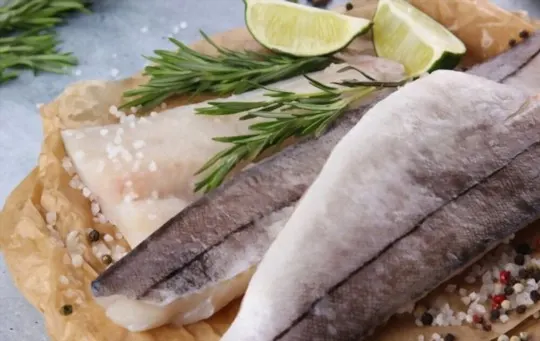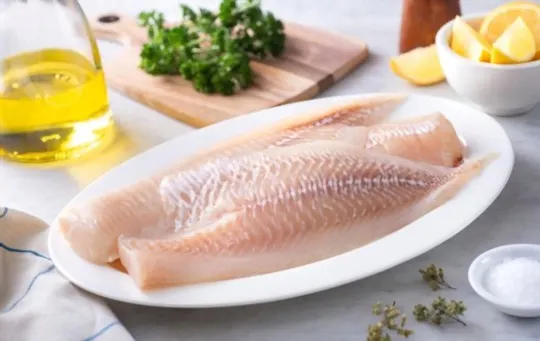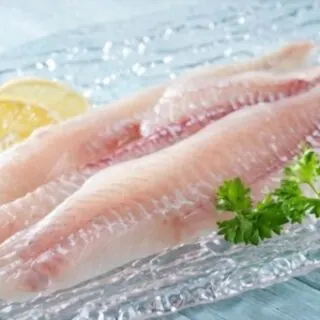Are you curious to know what haddock tastes like, but don’t know where to start?
You’re in the right place.
Today, we’ll discuss everything you need to know about haddock and its unique flavor.
Learn how to prepare this delicious fish for a mouthwatering experience.
What is Haddock?

Haddock is a white fish native to both sides of the North Atlantic Ocean and is mainly found in waters near Iceland, Norway and Canada.
It has a mild, sweet flavor and can be enjoyed as both fresh or frozen fish.
The texture is firm but it must be eaten fresh otherwise it has a tendency to become dry.
The most common types of preparation for haddock include pan-frying, poaching, steaming and baking; however, there are also some recipes that call for grilling or barbecuing.
It’s important to note that haddock should not be overcooked so as to preserve its unique taste.
Haddock is high in both protein and omega-3 fatty acids; the latter being particularly beneficial for those looking for a heart-healthy food option.
The taste of haddock can vary by region since freshness creates slight differences in flavor from one area to the next.
Generally speaking, haddock has a mild flavor with hints of butter, sweet notes of prepared citrus fruits and just subtle hints of saltiness carried on from where it is sourced from in the ocean.
What Does Haddock Taste Like?

When it comes to seafood, haddock is among the most popular and widely enjoyed.
Prized for its mild flavor and delicate texture, haddock is cherished by many seafood lovers around the world.
At first bite, many people describe haddock as having a slightly sweet taste with a mild buttery flavor.
While this may sound plain at first, the flavor of haddock can be enhanced when cooked with seasonings or sauces to give it an added depth of taste.
Haddock has a light texture that allows for experimentation with a wide range of flavors without overwhelming the fish.
Haddock is generally available as fresh fillets or steaks throughout the year in most grocery stores.
When purchasing fresh haddock, look for even-colored flesh that’s firm to the touch and free from any dark spots or bruising on the individual fillet pieces.
In terms of fish preparation methods, haddock can be baked, grilled, or fried with ease—making it a go-to option for busy weeknights.
Try your hand at some classic recipes like New England-Style Baked Haddock or Potato Chip-Crusted Fried Haddock—you won’t regret it.
In fact, you’ll find yourself reaching for this timeless favorite more often than not once you’ve tasted its deliciousness firsthand.
Factors that Affect the Taste of Haddock

Haddock is characterized by its mild and slightly sweet flavor, though the exact taste may vary depending on the species, size, fishing method, cooking technique and season.
The gray Atlantic haddock (Melanogrammus aeglefinus) has a milder taste than cod.
Haddock is often compared to cod but generally found to have a more subtle sweetness than its white fish cousin.
When cooked correctly, haddock should have a flaky texture that easily breaks apart with just your fork – this is a good indication of the freshness of the fish.
There are several factors that may affect the flavor and texture of cooked haddock.
This includes:
- The age and size: Haddock that has been freshly caught will tend to be more flavorful than old-aged fish as they absorb flavors better while they are fresh since they do not contain much fat. Larger fish will also tend to be more flavorful since they contain more oil in their flesh.
- Fishing methods: Different fishing techniques such as netting or trolling will affect how well the skin on haddock retains moisture when cooked which ultimately impacts the flavor.
- Cooking technique: The way you cook your haddock will also impact how it tastes; baking, steaming and deep frying are some common methods that can all produce different results for varied tastes in your plate.
- Seasonality: Since haddocks are seasonal fish, their taste may also depend upon what time of year it is being caught from certain regions which can alter their natural sweetness even further.
1 – Age and Size
When it comes to haddock, the age and size of the fish can have a significant influence on the texture, flavour and overall taste experience.
Generally, small haddocks (under two years old) have a firm texture and sweet flavour while larger haddocks tend to be softer in texture with a slightly saltier taste.
The colour of the skin on a haddock can range from off-white to slate grey depending on its age.
The flesh is white and usually contains small dark spots which easily flake away when cooked.
Fresh haddock will have bright eyes, clear skin and gills that are lightly red.
2 – Diet and Environment
Haddock is a mild-tasting white fish that is part of the cod family.
Its delicate taste can make it a bit tricky to prepare – unless, of course, you’re an expert.
However, its incredible flavor provides a unique spin on traditional fish chowders and other dishes.
Plus, you’ll be able to get your daily dose of healthy omega-3 fatty acids and other nutrients.
The diet and environment in which haddock swims affects the flavor – and quality – of the fish.
Generally speaking, warm sea water yields more succulent haddock with an exquisite taste.
Haddock farmed in chillier waters tends to be gristly and less flavorful.
For this reason, when buying haddock for consumption, look for wild-caught varieties either from chilled northern Atlantic waters or from Scotland’s temperate regions.
Additionally, consider smoking haddock for added flavorings as this will take away some moisture as well as offer complexity to its overall taste profile.
3 – Preparation Method
Haddock can be eaten in a variety of ways, from baked to fried.
Traditional cooking methods bring out the delicate flavor profile of haddock, letting it shine in recipes or as a stand-alone dish.
If you’re looking for new ideas on how to prepare haddock, here are a few popular choices.
Baked Haddock – Baking is an easy way to get maximum flavor out of your haddock without much effort.
Preheat your oven and lightly oil the bottom of a baking pan with butter or olive oil.
Place the haddock fillets into the pan and sprinkle with lemon juice and any desired herbs.
Bake uncovered at 375°F (190°C) for 15 minutes or until it flakes easily when tested with a fork.
Fried Haddock – Frying is one of the most popular ways to cook this type of fish as it gives it an extra crunchy exterior while keeping its soft middle intact.
Heat enough oil in a frying pan so that it covers 1/4 inch (6 mm) deep across the surface of your pan before adding the haddock fillets one at a time.
Season lightly before flipping over each piece until both sides become golden brown (around 3-5 minutes).
Remove from heat and serve immediately with your choice of condiments such as tartar sauce or ketchup, depending on preference.
Steamed Haddock – Steaming is an easy way to retain moisture while cooking haddock without overloading it with fats or oils like other cooking methods require.
To start, fill shallow saucepan two-thirds full with fish stock, clam juice, wine or water seasoned to taste with herbs and spices.
Bring liquid to a simmer before arranging hake fillets on wire steaming rack placed in metal pan above liquid level.
Cover and steam gently for 8-10 minutes checking for doneness every 2 minutes by flaking gently but firmly test each piece center portion meets desired doneness.
Serve hot along side cooked vegetables or additional garnishes such as grilled lemon slices , freshly chopped herbs , diced tomatoes , onions , garlic etc.
How to Cook Haddock to Enhance Its Flavor?

Haddock is a firm white-fleshed fish well-known in many parts of the world.
With mild and delicate flavors, haddock has a great texture that pairs well with diverse ingredients, making it something of a culinary chameleon.
For those just getting accustomed to cooking with haddock, there are a few tips to keep in mind that will help you get the most out of your dishes.
The most important factor when cooking haddock is to not to overcook it, as this will lead to dryness.
Haddock should be cooked until just opaque, which usually takes about 4-7 minutes for each side.
While methods such as steaming or microwaving can preserve more moisture and nutrients, baking or frying are better choices for bringing out the flavor of haddock as they add texture and browning that cannot be achieved by other methods.
Using aromatic herbs and foods such as garlic, lemon juice and capers may help enhance the flavor of your dish while also providing some appealing color contrast to the stark white flesh of the fish.
If you’re looking for an even more intense flavor experience, consider marinating your haddock in garam masala or cayenne pepper mixed with olive oil before cooking — this will continue to develop flavors later on during eating.
Additionally, breadcrumb mixtures can be used for added crunch if desired.
Allowing time for these flavors develop together, whether through marinating or other slow cooking techniques like poaching (warming in broth), will ensure maximum taste from each bite.
Is Haddock Healthy?
Haddock is a species of fish in the cod family and is one of the most popular fish for consumption.
It has a delicate, white flesh that has a mild and nutty flavor.
Many people describe its taste as sweet, mild, and somewhat buttery with a succulent texture.
In addition to its unique flavor, haddock also offers many health benefits.
Haddock is an excellent source of lean protein that is low in fat and contains essential vitamins and minerals like vitamin B12, phosphorus, selenium, zinc, and magnesium.
It’s also rich in omega-3 fatty acids which offer numerous health benefits including reducing inflammation and improving heart health.
Haddock also provides heart-healthy fats that can help lower cholesterol levels which could be beneficial to overall health in the long-term.
Haddock is often used in dishes such as fish cakes or fish recipes due to its subtly flavored meat which allows other flavors to shine through well but it can be cooked simply with just salt and pepper for those preferring keeping things simple.
It’s very versatile so you can use it in many different ways including baking, grilling, broiling or even pan frying it for a delicious meal.
Where to Buy Haddock and How to Store It?

Haddock is a mild-flavored white fish that can be found in grocery stores and seafood shops all over the world.
It’s easy to prepare with a variety of recipes, and its delicate flavor lends itself to many cooking methods.
Depending on where you live, you may find haddock fillets, steaks, or even whole fish that have been cleaned.
When selecting haddock, look for fillets or steaks that are opaque and firm.
If you buy a whole haddock, it should have shiny scales and red gills with no offensive odors.
When shopping at the seafood counter, ask if any of the fish has been previously frozen — many fresh haddock available in supermarkets has usually been frozen but thawed for display purposes.
If possible choose fresh never-frozen haddock since it will have a much better flavor, texture and overall quality.
It’s best to store your fresh haddock immediately in an airtight container in the refrigerator for up to two days before preparation.
If freezing your haddock make sure that it is wrapped properly so that no moisture gets inside.
When it comes time to prepare your meal be sure to drain off any residual water from thawed fish before cooking it as well as remove any bones with tweezers or carefully by hand if needed before serving.
Conclusion
In conclusion, haddock has a mild and pleasantly sweet flavor with a delicate buttery texture.
It is not fishy in taste, rather it has a subtle hint of salty ocean air.
When cooked properly, haddock can be incredibly delicious and flavourful.
Its flaky texture and mild flavor make it an ideal ingredient in recipes like fish cakes, fish fillets and its pleasant flavour makes it extremely popular across all kinds of cultures.
As always, when purchasing any type of seafood make sure to buy only sustainable and traceable produce that is caught with responsible fishing practices that promote conservation and minimize negative environmental impacts.

What Does Haddock Taste Like? A Comprehensive Guide
Ingredients
- Haddock
- Ingredients from your selected recipes
Instructions
- Select your favorite ingredient from the range available in this article.
- Collect all the necessary items to make the recipe.
- Use the instructions provided to prepare a delicious dish in 30 minutes or less.

Carrie is a food writer and editor with more than 15 years of experience. She has worked for some of the biggest names in the food industry, including Bon Appétit, Food & Wine, and Martha Stewart Living.
As the Editor in Chief of IntroChicago.com, Carrie oversees all of the content on the site. She also manages the team of contributing writers and editors, who help to create delicious recipes, helpful tips, and informative articles that you’ll find on the site.
A native of the Chicago area, Carrie is passionate about all things food. She loves trying new restaurants and experimenting with new recipes in her kitchen. She’s also a graduate of the Culinary Institute of America, so she knows a thing or two about food!
